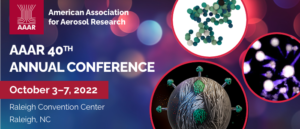Dear Colleagues: 
Thank you to all who attended the 39th Annual American Association for Aerosol Research Conference, which was held virtually October 18-22, 2021. This was the second consecutive AAAR conference held virtually, in light of the ongoing COVID-19 pandemic. In spite of the virtual format, the conference attendance remained high, with nearly 600 technical presentations distributed across 58 distinct technical sessions. Technical presentations were recorded in advance by presenters and viewed in advance by attendees, with live sessions consisting of 1-2 minute overview presentations by presenters with ample amounts of time for Q&A.
In addition to traditional sessions focused on a wide range of topics – from Aerosol Physics, Clouds and Climate, Bioaerosols, Combustion, and more – the conference featured four unique special symposia:
- Jimmy Radney and Chris Zangmeister of the National Institute of Standards and Technology co-chaired a special symposium bringing together researchers working in the broad area of “aerosol standards” that includes reference materials, reference methods, and reference data.
- Shanna Ratnesar-Shumate from University of Nebraska Medical Center, Paul Dabisch of the National Biodefense Analysis and Countermeasures Center, and Gedi Mainelis from Rutgers University co-chaired a special symposium on Infectious Aerosols in the Age of COVID-19, devoted to presentations on the latest results in understanding aerosol-based transmission of respiratory diseases and methods to mitigate aerosol-based disease spread.
- Nina Vance from the University of Colorado, Andy Grieshop of NC State University, and Rachel O’Brien from the College of William & Mary put together and co-chaired a unique special symposium on “Translating Aerosol Research for Societal Impact: Science Communication and Public Outreach”. The first of its kind at a AAAR conference, the symposium enabled an exchange of ideas and experiences to advance the aerosol science research community and to bring benefits to the broader society and the environment.
- Amara Holder, Yong Ho Kim – both from the Environmental Protection Agency – along with Jeff Pierce from Colorado State University co-chaired a special symposium on Wildfire Aerosols. In the wake of devastating wildfires in Australia in 2019 and the western United States in 2020, the symposium brought together researchers seeking to understand the characteristics of smoke emitted from wildfires, fires in the wildland-urban interface, and other landscape fires (prescribed and agricultural burning) and how this smoke impacts ambient and indoor air quality, human health, and climate.
The highlights of the conference were undoubtedly the plenary sessions each morning and Thursday evening.
- The opening plenary session on Monday was given by Kim Prather, UCSD & Scripps Institution of Oceanography, who gave an inspiring ASEEP lecture on “Tiny Critters, Huge Impacts: Ocean Microbes, Climate, and Health.” This talk highlighted many of the key findings from Professor Prather’s career in developing and utilizing ATOFMS measurements to better understand the composition of individual atmospheric particles and discussed the key results from the NSF Center for Aerosol Impacts on Chemistry of the Environment (CAICE), which she directs.
- Yifang Zhu from UCLA gave the Friedlander lecture on Tuesday; titled “Electronic Cigarette: The Knowns, Known Unknowns, and Unknown Unknowns.” Her presentation focused on the current understanding of particle formation and growth from e-cigarettes, as well as what is known about the health effects of e-cigarette aerosols. Professor Zhu’s lecture was dedicated to her advisor, the recently passed Professor William Hinds, who was a long-time AAAR member, and is perhaps best known for authoring the seminal textbook “Aerosol Technology.” A new edition of “Aerosol Technology,” now co-authored by Professor Hinds and Professor Zhu, will be released shortly.
- On Wednesday, Murray Johnston of the University of Delaware provided a plenary lecture on “Aerosols in Chemistry and the Chemistry of Aerosols.” First providing an excellent history on chemical measurements in aerosols and the application of mass spectrometry in aerosol science, Professor Johnston presented results on the latest approaches to analyzing particles via droplet ionization technologies, demonstrating both how to apply novel analytical techniques to characterize particle chemical composition and how aerosol science principles can be used to design new analytical techniques.
- The Thursday morning plenary session was provided by Angela Violi, University of Michigan, and was titled “Mechanisms of Nanoparticle Formation and their Health Effects.” Professor Violi’s talk focused on applications of atomistic simulations towards understanding not only soot formation pathways at the molecular level, but also the interaction of nanomaterials with cellular membranes.
- The closing Thursday afternoon plenary session was given by Randall Martin, Washington University in Saint Louis, titled, “Fine Particulate Matter: Interpreting Satellite Observations to Advance Understanding for Health Applications.” Focused on utilizing satellite measurements as a means to monitor PM 2.5 concentrations around the world, Professor Martin’s talk highlighted the need for combined ground and satellite measurements to understand variations in PM 2.5. concentrations around the world, and the resulting health and climate effects of these particles.
Plenary sessions closed with the announcement of new AAAR Fellows, the inaugural Susanne V. Hering Award Winner, the Friedlander Award Winner, the Mercer Award Winner, the Whitby Award Winner, the Liu Award Winner, the Sinclair Award Winner, the Aerosol Science & Technology Outstanding Publication Award, the Aerosol Science & Technology Outstanding Reviewer Awards, and the winners of the Fine Particle Art Competition. Each year, AAAR has a number of worthy nominees for all of these awards, and all the award winners and their nominators deserve a healthy congratulations!
See all the 2021 Annual Award Recipients and our two new AAAR Fellows here!
The conference would not have been possible without the considerable efforts of the AAAR working group chairs, session chairs, presenters, AAAR committee members, and the AAAR membership as a whole. We hope to see you for #AAAR2022 in-person in Raleigh, North Carolina next October 3-7! And, hopefully, the 39th Annual Conference is the last conference held solely in a virtual format!
Chris Hogan
2021 AAAR Conference Chair
This issue’s Newsletter Committee:
Editor | Kerry Kelly, University of UtahSenior Assistant Editor | Krystal Pollitt, Yale UniversityJunior Assistant Editor | Justice Archer, University of BristolGuest Contributor | Dong Gao
